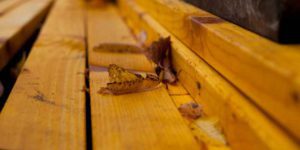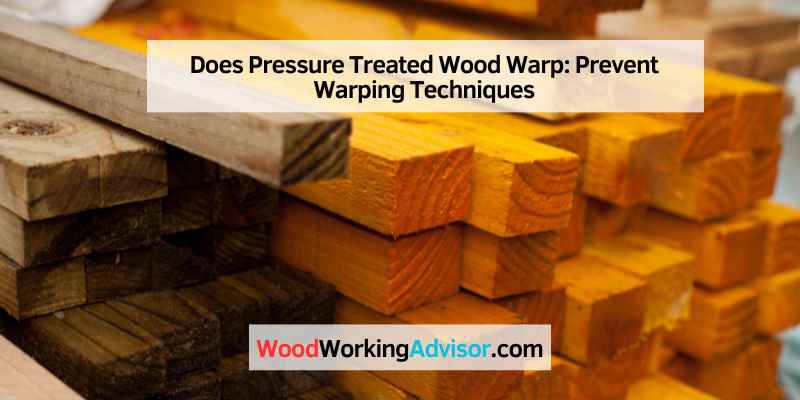Pressure treated wood can warp due to its natural tendency. Proper storage techniques can help prevent warping.
Pressure treated wood, a popular choice for outdoor projects, undergoes a treatment process to protect it from decay and insect damage. However, despite its durability, pressure treated wood is prone to warping if not handled and stored properly. Warping occurs due to the irregular grain patterns established during the tree’s growth.
To minimize the risk of warping, it is essential to store pressure treated wood on a flat surface, ensuring that all boards are of uniform thickness and properly stacked with stickers for ventilation. By implementing these storage practices, you can maintain the structural integrity and aesthetics of your pressure treated wood projects.
Preventing Warping Techniques
To prevent warping in pressure-treated wood, ensure uniform thickness in stacked boards, use stickers for alignment, and provide a flat foundation for storage. Certain woods like Oak and Cedar exhibit less warping tendencies due to enhanced dimensional stability against moisture.
Proper drying techniques in well-ventilated areas can help minimize warping issues with pressure-treated wood.
When it comes to pressure treated wood, warping is a common concern. However, there are several techniques you can implement to prevent or minimize warping. By following these practices, you can ensure that your pressure treated wood remains structurally sound and aesthetically appealing for years to come.
Proper Storage Techniques
Proper storage techniques play a crucial role in preventing wood from warping. When storing pressure treated wood, it is essential to keep all boards and stickers placed between them of uniform thickness, especially when they are in the same layer.
The stickers should lie flat and be vertically aligned, providing even support to the boards. Additionally, ensure that the lumber piles rest on a flat foundation, avoiding uneven pressure that could cause warping.
Choosing The Right Wood Species
Selecting the right wood species is another effective way to prevent warping. Some wood species, such as Iroko, Oak, Western Red Cedar, Cherry, and Maple, are known for their excellent dimensional stability and high resistance to shrinking and warping. By choosing these wood species, you can significantly reduce the chances of warping, even when exposed to moisture.
Drying Techniques
Properly drying pressure treated wood is essential to minimize warping. When drying the wood, it is recommended to place it in a dry, well-ventilated area. For large pieces of wood, consider using a drying rack to allow for even airflow. If possible, expose the wood to direct sunlight or use a fan or dehumidifier to expedite the drying process and reduce moisture content.
Using Supports And Bracing
Using supports and bracing techniques can help prevent warping in pressure treated wood. When constructing structures or furniture with pressure treated wood, ensure that adequate support and bracing are in place. This will help distribute weight evenly and reduce the likelihood of warping over time.
Avoiding Moisture Traps
Moisture is a primary contributor to wood warping. To prevent moisture from causing warping, it is essential to avoid moisture traps. Ensure proper drainage around pressure treated wood structures and furniture. Avoid placing pressure treated wood in direct contact with the ground, as this can lead to moisture absorption and potential warping.
Applying Protective Coatings
Applying protective coatings to pressure treated wood can provide an extra layer of defense against warping. Water-resistant coatings, such as sealants or stains, can help repel moisture and protect the wood from warping. Regularly inspect and maintain the coatings to ensure their effectiveness over time.
Regular Maintenance
Regular maintenance is crucial to prevent warping in pressure treated wood. Periodically check for signs of warping, moisture damage, or other issues. Fix any abnormalities promptly to prevent further damage and ensure the longevity of your pressure treated wood.
Working With Experienced Professionals
Finally, working with experienced professionals is vital when it comes to preventing warping in pressure treated wood. Professional builders, contractors, or carpenters have the knowledge and expertise to implement proper techniques to minimize warping risks. Their guidance and craftsmanship can significantly contribute to the overall quality and longevity of pressure treated wood structures and furniture.
By following these preventing warping techniques – proper storage, selecting the right wood species, drying properly, using supports and bracing, avoiding moisture traps, applying protective coatings, regular maintenance, and working with experienced professionals – you can ensure that your pressure treated wood remains in optimal condition, free from warping and distortion.
Implementing these practices will not only enhance the aesthetics of your projects but also prolong their lifespan, saving you time, effort, and costs in the long run.

Frequently Asked Questions For Does Pressure Treated Wood Warp
How Do You Keep Pressure Treated Boards From Warping?
To prevent pressure treated boards from warping, ensure consistent board thickness and flat, vertical stickers in storage. Stack on a flat foundation and use well-ventilated drying areas if necessary. Choose lumber with high resistance to warping, like Iroko, Oak, and Cherry.
Proper storage and handling minimize warping.
What Wood Is Least Likely To Warp?
Several types of wood are less likely to warp, including Iroko, Oak, Western Red Cedar, Cherry, Maple, and heat-treated woods. These woods have excellent dimensional stability and high resistance to shrinking and warping, especially in moist conditions.
How Do You Dry Pressure-treated Wood Without Warping?
To dry pressure-treated wood without warping, store it in a well-ventilated area. Consider using a drying rack, placing it in the sunshine, or using a fan.
Does Treated Wood Warp More Than Untreated?
Pressure treated wood tends to warp more than untreated wood.
Conclusion
Preventing pressure-treated wood from warping involves proper storage and ventilation techniques. Stacking boards uniformly, ensuring flat stickers, and using a dry, well-ventilated area during drying are key. While some warping may occur, following these tips can minimize it for a more stable construction material.


